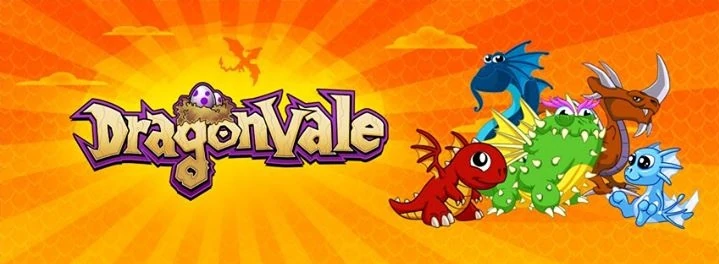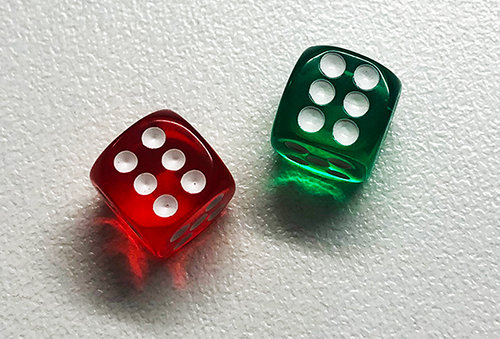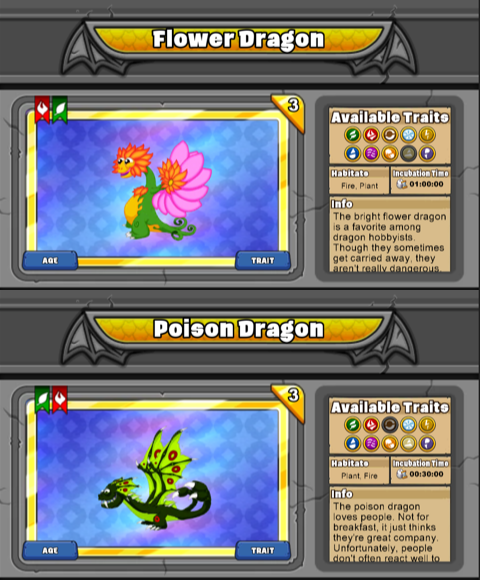
I’ve been playing Dragonvale, since it was released in 2011, off and on. And ever since I got heavily into modern board gaming, I’ve been trying to think of a way of combining these two passions. But Dragonvale is very much a game for the long haul; literally played over months and years; collecting dragons as they were added. I could not think of a way to turn that into a 60 minute experience, that you would want to repeat each time you played the game. However my latest return to Dragonvale, comes after Rob Daviau led the boom of the campaign legacy game. And an ongoing campaign, that keeps track of previous plays, and introduces new elements over time, is exactly what a Dragonvale board game should be.
Collecting the Dragons
Dragonvale has an economic framework at its core. The dragons earn DC (dragon cash) that you use to buy habitats, and decorations. You also use it to farm food, which feeds the dragons so they can level up, and earn DC, so you can buy more habitats, etc. And all these things earn XP (Experience Points), so the players can level up, and get access to new dragons. This “resource exchange” is found in any number of Euro board games, and we’ll examine it in later posts. But the fun of the game, is in dragon collecting.
Primary dragons are introduced as you level up in the game: 10 in total in Dragonvale. And from these 10 dragons, more than 600 other dragons can be bred. There are:
- regular hybrids; pairings of the 10 elements, which are available all year round
- epic dragons; brand new types of dragons, that can result from the correct collection of elements
- limited dragons; which only occur at certain times of the year
There are also limited epic dragons, which are exactly like they sound, and a handful of other special types, which we won’t worry about here. Recreating the experience of leveling up a dragon park over time, as limited dragons come and go, seems easy enough. A campaign of 12 games could have each of those games represent a calendar month. The primary elements can be released throughout the campaign, so the number of regular hybrids increases on each release. Epics become available when the right collection of elements has been added to the campaign. And limited dragons can be released with some of the games, so you only have that one game to collect it. For example, you only have the “October game” to breed the limited “Halloween dragon”.
What are the odds?
I have been posting a lot about dragon breeding percentages in Dragonvale of late. Every new event comes with a selection of limited dragons that each have various ways of collecting them. When thinking about odds of something happening, it is natural to compare it to the roll of some dice. There is a 3% chance of breeding a Sun dragon, for example. This is close to the odds of rolling double 6 on 2×6 sided dice (2.77%). Not that you would want the breeding chances to be that low in a game with limited turns, but you get the idea. You can use a dice roll to set a dragon breeding chance. This makes it the obvious way to recreate dragon breeding in a board game.

Regular Hybrid Dragons
There are also 2 possible regular hybrids with each pair of elements, and you have equal chance of getting either one. You can think of it like a main/1st element and a secondary element. The first 2 elementary dragons introduced in Dragonvale are Plant and Fire. Breeding those 2 dragons together will create a fire/plant dragon – Flower; and a plant/fire dragon – Poison.

The 2 obvious take aways from this are; there should be a coloured die for each primary element in the game, and when rolling them to produce regular hybrids, the coloured die with the larger number is the 1st element. 5+3 = Flower. 4+1 = Poison. Doubles roll again, until you get a result.
Things get trickier when you add a third element; say when you breed a Flower dragon with an Earth dragon. You now roll 3 dice, but the basic rules still apply.
- If all dice match, reroll them. Else,
- Separate the dice into the largest rolled number, turning those dice onto a 6 (for clarity) and the smallest rolled number, turning those dice onto a 1. Discard any others.
- If there are more than 1 die in the largest number group, reroll them, until 1 of them is the largest number of that group. That is the 1st element.
- If there are more than 1 die in the smallest number group, reroll them, until 1 of them is the smallest number of that group. That is the 2nd element.
Epic Dragons
Needing to reroll doubles, seems like an annoyance. But it actually means there are rolls of the dice that initially aren’t being used, and are available later as the game develops. I’ll continue with the Sun dragon example I was using above. In Dragonvale they have a 3% of being bred when a breeding combination has cold & lightning as 2 of the elements. As we said above, that’s close to when the cold and lightning die both show a 6. So if the Sun epics were added to a board game, you would just add 1 thing to check before checking for a regular cold + lightning hybrid. If the “white” & “yellow” dice both show a 6, then you have bred a Sun dragon.
This would get trickier when more epics become available, regarding which to check first. It will be important to minimise the overlap between the success rules for multiple epics.
Limited Dragons
Limited dragons generally have a higher chance of getting them than epics, because you have a small window of opportunity. We could again use up some of the unused double rolls for the breeding opportunity, but sometimes a limited can have more than 2 elements. The Panlong dragon, made available in the Chinese year of the dragon, which started in 2012, had the 4 elements, Fire, Earth, Air and Water, and has a 3% chance of breeding it (when it’s available). How could we recreate a 3% chance when there are 4 dice being rolled?
There are 1296 different rolls, with 4 x 6 sided dice, and 3% would be about 39 of the possible rolls. Rolling 3 of a kind (or better) on 4 dice (So 1+1+1+x), covers 21 combinations. Therefore asking for 3×5 or 3×6 with those 4 dice would cover 42 combinations, and be slightly better than 3%. So adding a first breeding check of
- “If you roll at least 3×5’s or 3×6’s you have bred a Panlong dragon”
would do the trick.
We could also just add a sum check.
There is 1 way of rolling 24(4x6s).
There are 4 ways of rolling 23 (3x6s and 1 of the 4 dice shows a 5). So there are 5 (1+4) ways of rolling 23 or up.
There are 10 ways of rolling a 22 (a combination of 3x6s and 1×4 OR a combination of 2x6s and 2x5s). So there are 15 (1+4+10) ways of rolling a 22 or up.
There are 20 ways of rolling a 20, and I think I’m just going to ask you to trust me on that one. But it means there are 35 (1+4+10+20) ways of rolling 20 or higher, which again is pretty close to the 3%. So adding a first breeding check of
- “If you roll 20 or higher, you have bred a Panlong dragon”
would also do the trick. So there are choices. There might be times when more than 1 limited could be available, so again, it would be important that there is no overlap.
So That’s the Fun …
Recreating dragon breeding through the rolling of dice seems to be a solid idea. It should be a great way to collect all those cute dragons during the course of the campaign. Now it’s just a matter of mapping out the course of the campaign, fleshing out what happens in each game, and sorting out the resources and economy that the whole game is built on. More posts to follow.
All the posts for the development of this Dragon Collecting Board Game can be found at the Index Page.
